Disclosure: Some posts contain affiliate links, which earn us a commission if you make a purchase through them. Positive Fishing © participates in various affiliate networks including the Amazon Services LLC Associates Program.
Using natural bait is a real winner when fishing for trout in heavily fished rivers. On certain days, trout just don’t seem interested in taking any artificial bait, no matter how hard you try.
If you have the luxury of targeting trout with natural bait, there are several options that you need to have on hand. While most fish are happy to strike these living baits, trout are especially eager to go after what many anglers call the most effective options you can use anytime.
Trout, while taking live bait, tends to hold onto it longer and often gorge it down into their stomach. This results in the fish invariably swallowing the hook, making the catch and release practice more of a challenge.
Check your local regulations before you target trout with any live bait as some locations have regulations. Once you’re in the clear, ensure you have at least a couple of the following baits on our list on your next fishing trip.
In this article, I will cover:
- The 7 Best Natural Baits and How to Fish With Them
- Nightcrawler (Our Best Overall Pick!)
- Crickets/Grasshoppers (Our Most Versatile Pick!)
- Crayfish
- Fathead Minnow
- Stonefly
- Wax worm
- Sculpin
- When to Use Live Bait
7 Best Natural Baits For Catching Trout
While there are numerous options for live bait, the following seven will produce the most fish and the easiest to find. However, it’s always smart to check with local anglers or bait shops to know what’s working best before you make your decision!
Nightcrawler – (Our Best Overall Pick!)
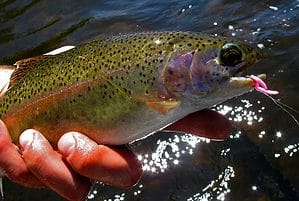
trout with natural baits
It’s hard to argue with an old-fashioned nightcrawler. Whether digging them out of your backyard or purchasing them at the local bait shop, never underestimate the power of a worm. Worms are easily accessible, attractive, and quite easy to fish with.
The first thing to know about fishing worms is where the fish are feeding. Fish feed on different levels depending on the time of day and even the time of year! As long as you know the fish aren’t feeding on the surface, you’re good to go ahead and fish a worm.
You can fish them along the bottom by attaching a weight or let them drift throughout the current! Again, knowing the trout feeding habits is important before you get going. Slip-sinker rigs are great options if you target them at the water column’s bottom.
Make sure you use a baitholder hook size between a #4 and #10 when fishing with worms. Attach the worm to your hook several times to ensure it stays on while you cast, but always let a bit of it hang off the end of your hook. This will help it with its natural appearance.
Check out my in-depth article with the best tips and methods on how to fish with worms, which answers all the typical questions anglers ask when using these “wrigglers”.
Crickets And Grasshoppers – (Our Most Versatile Pick!)
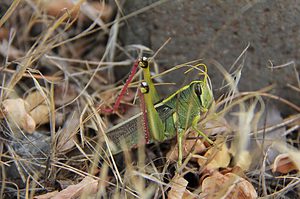
If you see trout on the surface late in the summer, you can assume they’re looking for terrestrials. Crickets and grasshoppers are like candy to trout! Since they aren’t always available, trout are eager to feed on them when possible.
To rig a grasshopper, it’s best to use a thin-wire hook. Push the wire just behind the head and stick the hook through the abdomen. This will create a more natural appearance and ensure the hopper isn’t going anywhere.
You must fish with a light leader to keep these on the surface. Cast near the banks or near vegetation. Hoppers and crickets will often fall into the water off of these, and trout are often waiting. Let your hopper or cricket float naturally, and you’ll quickly have a strike.
Crayfish
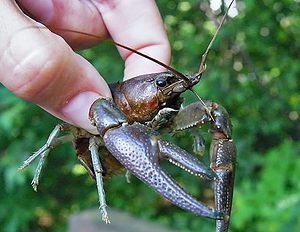
For fly anglers, throwing a crayfish fly almost automatically means a strike. Crayfish are a hearty meal for trout and in many trout rivers throughout the United States. If you know they’re in the river, get there an hour or so before you want to begin fishing and do some hunting.
Flip over rocks or look in slack parts of the water near shore. It won’t take long for you to gather a dozen or so crayfish. Cast these through pools or riffles and wait for the trout to strike. To attach crayfish most realistically, hook them through the tail. You will need to use large hooks for crayfish; a size #2 or #4 baitholder hook is the best option, and always let the natural movement activity of the crayfish do the trick.
Trout can be extremely aggressive. If you see one chase down your crayfish, keep up the action. Eventually, it will become so appetizing that they have to strike.
Note: In the United Kingdom, using crayfish as fishing bait is illegal – dead or alive!
Fathead Minnow
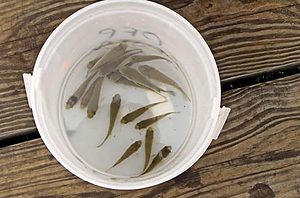
Any northern angler knows the power of a fathead minnow. These small fish will work on most predatory fish. Perhaps the best thing about fathead minnows is that they stay lively for quite a long time. You can easily get four or five good casts with these minnows before they lose their luster.
Use a size #4 baitholder hook and hook the minnow through the lip. This will keep it liveliest the longest. You have several options on how to fish with them! You can dead drift them through the current, fish them below a bobber, or keep them near the bottom. Again, do some research on your local water before you decide as to what would work best.
Note: In the United Kingdom, live bait can ONLY be used if it is caught in the same water as it is being used. There are no other restrictions on using live bait.
Stonefly
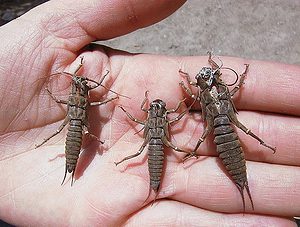
If you’re fishing anywhere out west in Montana or Wyoming, you’ll want to familiarize yourself with Stoneflies. These live in some of the most famous rivers in the Western United States, and trout love them! You don’t have only to reserve insects for fly fishing! Live stonefly nymphs are amazing trout bait.
Stonefly hatch works well throughout its life cycle. You should always look for the insects’ presence at the riverbank, especially when the stonefly emerges. It is important to remember that the timing when to use Stoneflies is key; water temperature and the type of Stonefly alter their emergence.
To fish with a Stonefly nymph, fish with a wire hook. A size #6 or #8 hook will work fine. Run the wire behind the head of the fly and place the hook through the abdomen. Your other option is to run a short-shank hook through the tail and out behind the head. Either option would work great.
Wax Worm
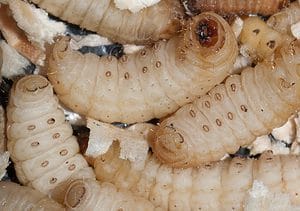
Yes, there is a major difference between wax worms and nightcrawlers. Waxworms are a common ice fishing bait, but they can work equally as well in the summer. These are bee larvae, and trout love to feast on them.
Rigging them properly can be tricky since they’re so small, but it’s not nearly as challenging once you get the hang of it. The slip-sinker rig works just fine! Attach a small egg sinker on the line above a barrel swivel. Then tie a two-foot leader to the opposite side of the swivel and attach it to your hook.
Your hook should be smaller with waxworms than most other natural baits; any size between #10 and #14 is the best. Don’t only attach one waxworm! Use four or five to make your baited hook look irresistible. Some anglers will position a float a few inches above the bait to keep it suspended off the bottom.
Sculpin or Bullhead
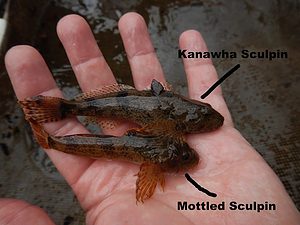
found in warmer waters
Sculpin should be at the top of your bait list in true trout fishing waters. These are rough looking small fish and live in water similar to which trout inhabit. When the water temperature is warm, the odds are you’ll find plenty of sculpin near the bank of the river, especially near the shallow and slower moving water. They have a similar appearance to suckers!
In the United Kingdom, they are called Bullheads. They usually grow to around 3″ to 6″ inches; I recommend using the smaller ones as they tend to attract more trout.
Hooking one of these through the lip will create the most effective movement. Use a size #4 or#6 hooks when fishing with them!
When Should You Use Natural Bait For Trout?
Live natural bait is productive at almost any time of the year! However, natural baits will be the number one choice when trout are picky or when the water is a bit stained. If you know the fish will be hard to catch, attach any natural live bait and see what happens – your chances will increase over using artificial lures.
If you are going for trout with flies or insects, then make sure that you check out the hatch period charts to maximize your chances of catching trout.
Final Thoughts
It’s hard to ignore the effectiveness of live bait. Given the options, most fish will be confident of eating natural food from its habitat. Due to this, when we want to catch any species and as many fish as possible, natural baits will do the trick.
Choose any of these best baits for trout from the list above, and you’ll quickly increase your catches.
If you liked this article, why not read my others on the best trout flies, covering nymphs, dries, and streamers, or some great tips on how to fly fish at night for big trout!
- Wading Belt Essentials: Ensuring Safer Fishing - January 9, 2024
- Fishing For Catfish (Top Tips, Bait, & Gear To Catch The Big 3) - October 20, 2022
- Fishing Line Strength Vs. Diameter Chart: Why Is It Important? - October 12, 2022

